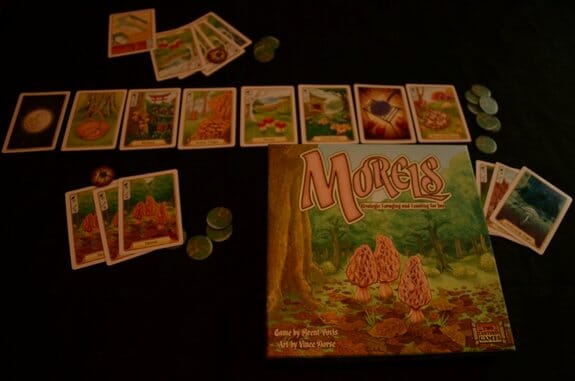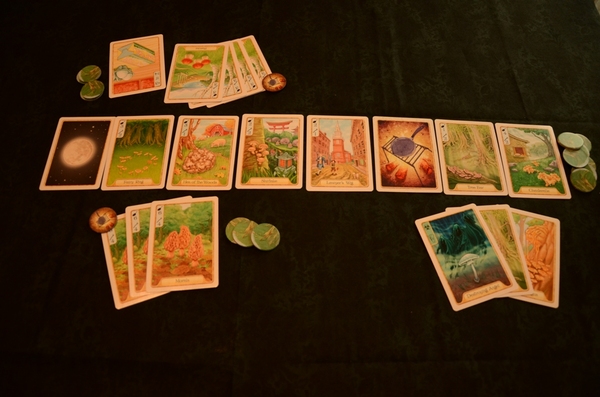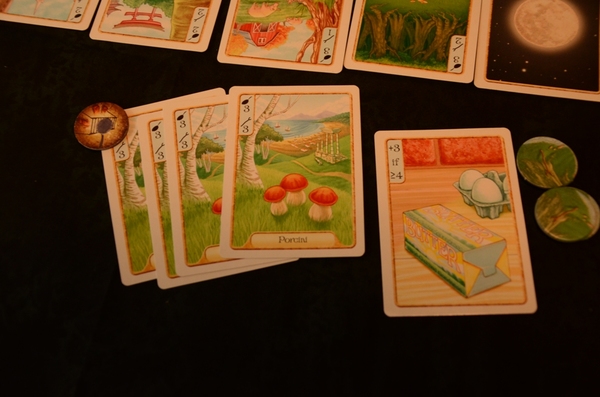
Morels is a new two-player card game where players take on the role of mushroom foragers, working to collect sets of cards depicting various mushroom types and either selling those cards for currency or cooking them for points. While some mushroom types are plentiful, others are scarce, and the opportunities to pick them are limited, creating competition with your opponent to collect the most valuable varieties while also forcing you to think two or three moves ahead to maximize the value of your turns.
The entire game comprises 96 cards and a handful of cardboard tokens representing sticks (the game’s currency) plus one frying pan for each player. The cards are then split into two decks, 88 cards in the day deck and eight in the special night deck, the latter of which is laid face-down adjacent to the main playing area. Each player receives a starting hand of four cards from the shuffled day deck, after which the “forest,” eight cards in a row, is laid out on the table to start the game. The two cards at the right of the forest are available for foraging for no cost; each card to the left of those two is available if the player spends from one to six sticks to forage them, with the number of sticks corresponding to the card’s distance from the two free cards. After each player’s turn, the forest shifts, with the rightmost card falling into the “decay” area, and every remaining card shifting to the right to fill in the empty spots. Therefore, the card you want or need may not be available for long, even if your opponent doesn’t claim it first.
The day deck contains cards of nine mushroom types for players to collect, from the cheap and unappetizing honey fungus (Armillaria mellea, a hardy, extremely long-lived mushroom, considered a delicacy in eastern Europe) to the true morel (genus Morchella, a wild mushroom often found after forest fires). The cheaper the mushroom, the more of its cards in the deck, and the lower its value when sold or cooked. The day deck also includes Basket cards, each of which allows the player to extend his hand limit by two cards; Pan cards, with one required for each batch of mushrooms a player wishes to cook; Butter and Cider cards, allowing for bonus points if cooked with sets of four or five mushroom cards; and Moon cards, one of which allows the player to draw a card from the Night deck. That deck contains one card of each mushroom type except Morels, and a Night card counts as two mushrooms for scoring or for meeting the minimums to sell (two cards) or cook (three) a batch of mushrooms.
Morels offers a balance between short- and long-term decision-making, mostly revolving around the constraint of the limit of cards a player may hold in his/her hand. That normal limit is just eight cards, before Baskets, and a player will frequently have to choose whether to cook a set of mushrooms now, locking in points and clearing space in his hand, or holding out to try to add additional cards to the set to raise its point value. Once a set of mushrooms is cooked, the player may not add any cards to that set, or remove any, so some cards still in the forest or in the deck will become useless because they won’t have enough similar cards still in play to form a complete set. Choosing cards from the forest invokes the same conflict between short- and long-term considerations, as well as the mechanic that means that taking a specific card likely makes the adjacent card unavailable to the same player on his/her next turn.
One of the simplest tactics in the game involves the Morel cards, of which there are only three, worth six points apiece when cooked—meaning that collecting all three and cooking them is an 18-point play in a game where a score in the 40s is often good enough to win. Preventing your opponent from acquiring all three is key, but if you pick up one or two Morel cards without getting the full set, you will end up with one or two dead slots in your hand that still count against the hamd limit of eight. You can try similar tactics on less valuable mushrooms, but only Morels offer the collector zero margin for error, and since there is no Morel card in the night deck, you can only be certain that you’ve properly stuck it to your opponent with this card type.
The game only offers one pitfall or obstacle, the Destroying Angel, of which there are five cards in the Day deck. Picking one up temporarily reduces your hand limit by four cards, forcing you to discard until you reach your new limit, which remains in effect for one additional turn per cooked pan of mushrooms in front of you. It is a minor inconvenience, and one very easily avoided, as there is no way to pick up a Destroying Angel by accident. With just five in the deck, the card only has one practical function, which is to occasionally make the Decay pile untouchable—and even then only if you don’t have Baskets to extend your hand limit so the pain of “digesting” the toxic mushroom is mitigated.
Morels reminded me most of Jaipur, the best pure two-player game I’ve tried, where players also compete to collect sets of cards from a central repository while dealing with resource and space constraints. In Jaipur, timing is critical, as the points received by trading in a set of cards can decrease as rewards are claimed over the course of a game. In Morels, the rewards are the same whether you cook a set of chanterelles at the beginning or end of a game; the major factor in deciding when to cook is whether you may increase your point totals by trying to add another card to the set. That makes the game simpler, and less cutthroat, but also makes the game more of a two-way solitaire endeavor because it has less direct interaction with your opponent.
A typical game of Morels takes 20 to 30 minutes once you know what you’re doing, and the cards sport impressive artwork depicting the various mushroom types. It’s also highly portable, as you could play the game with nothing but the deck and some coins to substitute for the stick tokens, and could even be played with kids once they’re able to match pictures (assuming you want to play without keeping score). It’s ahead of Lost Cities, probably the most popular gateway game for two players, sometimes known as a “couples” game for that reason, and while it falls a little short of Jaipur, it’s worth adding to your two-player game rotation along titles like Jambo and Battle Line.
Keith Law is a senior baseball writer for ESPN.com and an analyst on ESPN’s Baseball Tonight. You can read his baseball content at search.espn.go.com/keith-law and his personal blog the dish, covering games, literature, and more, at meadowparty.com/blog/.


